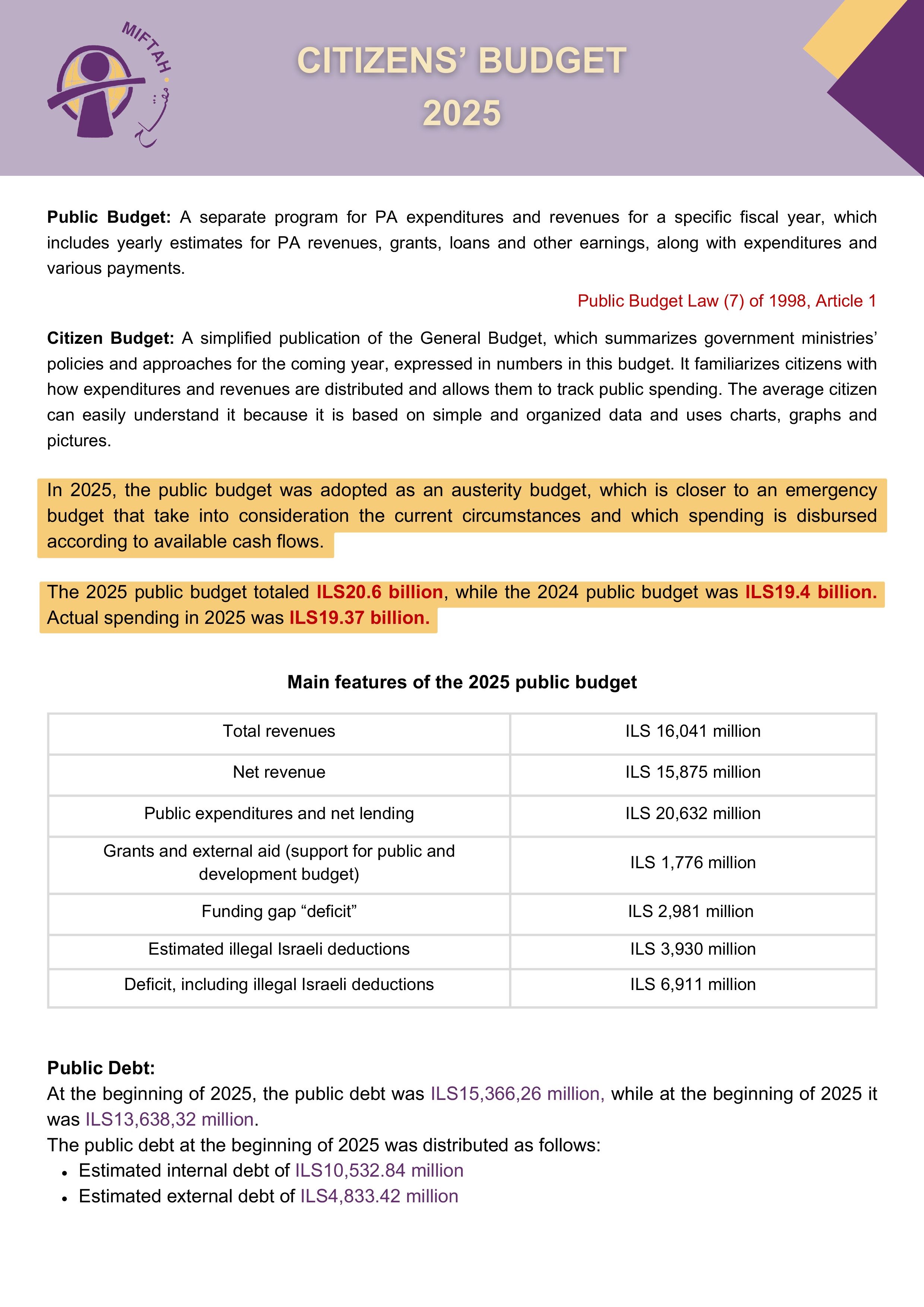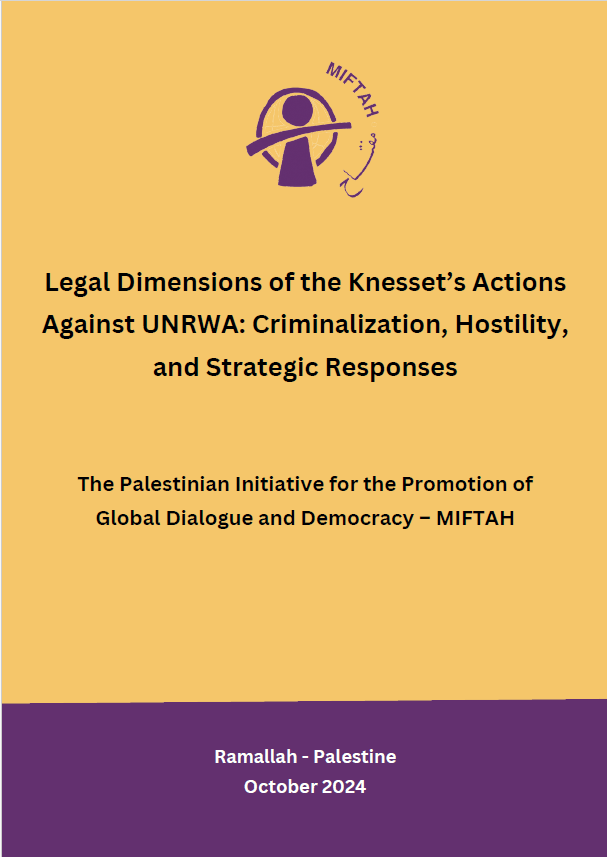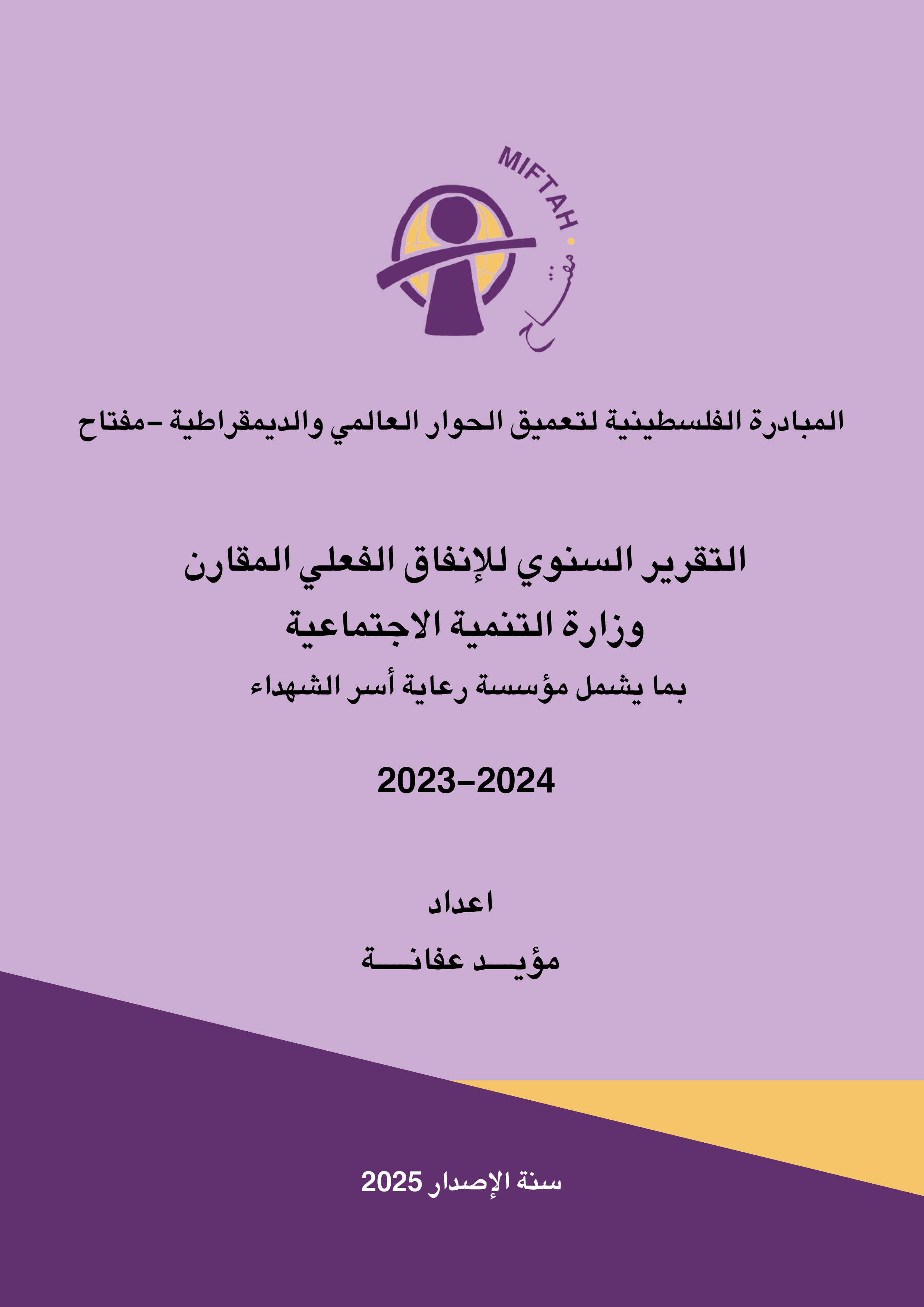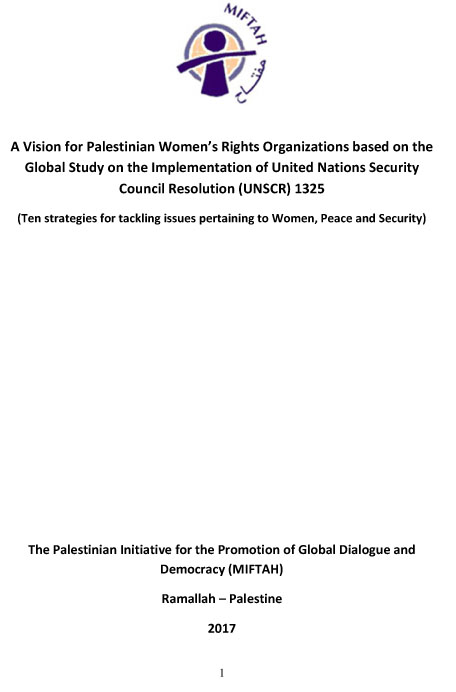The Future of Warfare and Global Accountability
Date posted: May 20, 2025
By MIFTAH
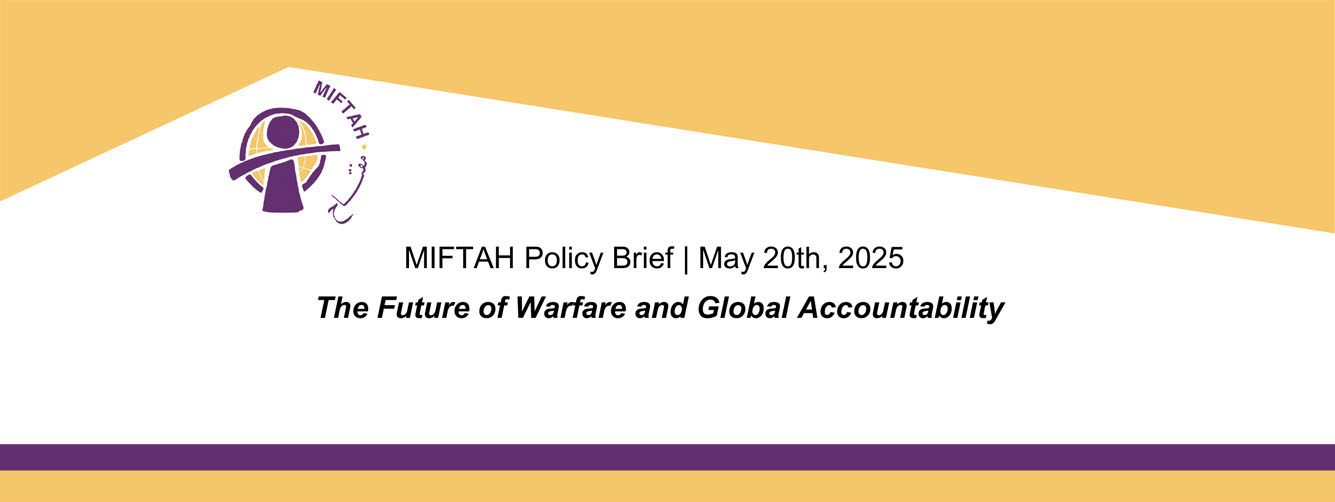
Executive Summary
The Israeli occupation of Palestinian territory is marked by the systematic violation of digital rights through state-sponsored surveillance, censorship, and structural digital inequality. These practices, including bio-metric surveillance, arbitrary arrests based on online activity, social media censorship, and denial of technological infrastructure, constitute a broader strategy of control that mirrors and reinforces the physical restrictions of occupation. The use of advanced surveillance technologies not only infringes on Palestinians' fundamental rights to privacy and freedom of expression, but also threatens global human rights norms through the international export of these technologies.
To view the Full Policy Paper as PDF
Israel’s Reproductive Genocide in the Gaza Strip
Date posted: April 29, 2025
By MIFTAH

Executive Summary
The ongoing genocide in the Gaza Strip has compounded several humanitarian and legal violations, particularly inrelation to the reproductive rights of Palestinian women. Since the launch of its military offensive in October 2023, Israelhas systematically targeted Palestinian women in ways that undermine their ability to survive, give birth, and raisechildren. More than 12,300 women have been killed, 4,700 women and children are missing, and approximately 800,000women have been forcibly displaced. An estimated one million women and girls now suffer from acute food insecurity.Israel’s actions constitute a deliberate attempt to impair the reproductive capacities of Palestinian women, aimed atdismantling the future of Palestinian society. Through the bombing of shelters, destruction of hospitals, blockading ofmedical and hygiene supplies, and attacks on fertility clinics and maternity wards, Israel’s policy of erasure is notincidental, it is intentional.
To view the Full Policy Paper as PDF
Israel’s Attack on UNRWA and Its Implications for Palestinian Refugees
Date posted: March 05, 2025
By MIFTAH

Executive Summary
The United Nations Relief and Works Agency for Palestine Refugees in the Near East (UNRWA) is vital inproviding humanitarian aid, education, and health services to Palestinian refugees across Jordan, Lebanon,Syria, and the Occupied Palestinian Territories. Beyond its humanitarian role, UNRWA represents aninternational commitment to Palestinian refugees' right of return, as established in UN General AssemblyResolution 194 in 1948. However, Israel has long sought to undermine the agency through financial, political,and military means.Recent Israeli actions have escalated, with the Israeli Knesset passing legislation banning UNRWAoperations in areas under Israeli control, effectively revoking its legal status. Concurrently, Israel hasintensified military attacks on UNRWA facilities. In the Gaza Strip since October 2023, Israeli forces havetargeted 310 UNRWA sites, destroying schools and killing 273 UNRWA employees alongside hundreds ofcivilians sheltering in its facilities. Throughout the occupied West Bank, the Israeli military has been turningUNRWA facilities into military bases and detention centers, and has closed UNRWA’s headquarters in EastJerusalem. These actions violate multiple international legal agreements and aim to erase Palestinian refugeeidentity and their legal rights.
To view the Full Policy Paper as PDF
Palestinian Women: The Disproportionate Impact of The Israeli Occupation
Date posted: November 21, 2018
By KARAMA
The shocking human cost that occupation has taken on Palestinian women is laid bare in research published today. Combining research, extensive surveys, and first-hand testimonies from over 40 Palestinian women, Palestinian Women: The Disproportionate Impact of The Israeli Occupation provides new insight into the gendered experience of occupation, looking into four issues in particular:
- women refugees
- the impact of residency revocation on Palestinian women in Jerusalem
- the experience of women prisoners
- Gazans’ access to health
Co-authored by four Palestinian NGOs – the Palestinian Initiative for the Promotion of Global Dialogue and Democracy (MIFTAH), Palestinian Working Woman Society for Development (PWWSD), the Women’s Centre for Legal Aid and Counselling (WCLAC), and Women Media and Development (TAM), the report includes detailed findings that demonstrate how the oppression occupation has permeated women’s daily lives, and the particular impact is has had on women in Palestinian refugee camps, Palestinian women living in Jerusalem, women prisoners, and residents of Gaza who require health services.
The impact on refugee women
Researchers spoke to 500 Palestinian refugee women from 12 Palestinian camps (7 in the West Bank, 5 in Gaza). Their findings included the following:
- A third of women surveyed had been directly exposed to physical assault by Israeli Occupation Forces. 9% had been exposed to threats of being attacked by police dogs during Israeli night raids on their homes.
- Over a third (37%) of respondents had been exposed to detention or interrogation, while 38% said that they or members of their households had been exposed to verbal abuse during Israeli army raids, at checkpoints or while visiting religious places.
- Nearly a quarter (24%) were forced to live in shelters or with extended family. 22% were forced to live under unhealthy conditions. 13% stated that the female and male members of their families were separated as a result of having to live in shelters.
- More than one in five (21%) had been exposed to beatings or tear gas at Israeli checkpoints while they were pregnant. 4% reported that they aborted or gave birth at Israeli checkpoints.
- The majority (64%- 321 cases) had been unable to visit religious or recreational places because of Occupation restrictions.
Jerusalem: Residency Revocation and Family Reunification
According to official figures, 14,595 Palestinians from East Jerusalem had their residency status revoked between 1967 and the end of 2016.
Through residency revocations, Israel has separated husbands from wives, parents from children, and extended families from one another, causing traumatic complications for women attempting to remain with their families in both Jerusalem and the West Bank.
This leads to traumatic fears of separation from children for mothers and an entrenching of patriarchal practices across society. Palestinian women living in Jerusalem lose residency rights if they get divorced or their husbands remarry. Limiting their access to justice, female victims of domestic violence fear reporting abuse to authorities in case they are forcibly transferred away from their children.
Women prisoners
Since the beginning of the Israeli Occupation of Palestine in 1967, approximately 10,000 Palestinian women have been arrested and detained by Israeli military forces. According to the Commission of Detainees and Ex-Detainees Affairs’ 2017 annual report, 1,467 children were arrested last year.
Our researchers spoke to prisoners who experienced physical and psychological torture at arrest and imprisonment, and traumatic, gendered treatment, including:
- Women denied access to menstrual products while detained
- A woman arrested while pregnant who gave birth while chained to a prison hospital bed
- Ex-prisoners who report being subjected to rape and death threats during interrogation, including a girl in of 15-years old threatened with rape
- Women who were subjected to frequent forced and violent strip searches
- A prisoner who reported toothache, only to have the wrong tooth removed
Access to Health in Gaza
Israel exercises strict control Gaza’s borders, a policy of ‘actual authority’, constituting continued occupation, despite the withdrawal of its permanent presence. This control in particular affects those who need medical treatment outside of Gaza’s struggling health system, who require permission to leave. The report shows that the rate of approval applications is falling year-by-year:
- 92.5% of applications were successful in 2012
- 88.7% in 2013
- 82.4% in 2014
- 77.5% in 2015
- 62.1% in 2016
Of the 26,282 permit applications submitted by patients aiming to exit through Erez in 2016, 8,242 (31.4%) were delayed. Many applicants received no response from border authorities, even after lawyers filed formal applications on their behalf. These delays regularly extend months and years beyond medical appointments, worsening already life-threatening diseases and in some cases resulting in death.
Read the full report here, or download it here:
Palestinian Women – The Disproportionate Impact of the Israeli Occupation
Palestinian Central Bureau of Statistics (PCBS), issued a press release on the Eve of the International Women’s Day
Date posted: March 10, 2018
By Palestinian Central Bureau of Statistics (PCBS)
Women represent half of the Palestinian population
The qualitative base of the structure of the population in Palestine the sex ratio stood at 103.3, which means that there are 103 males for every 100 females
The percentage of female-headed households
The percentage of female-headed households in Palestine was 10.6% in 2017, 11.2% in the West Bank and 9.5% in Gaza Strip.
fifth of the persons in Palestine got married at an early age (less than 18 years) in 2016
Early marriage reached to 20.5% among females and 1.0% among males of the total married population in Palestine; the rate was 19.9% out of the total married population in West Bank and 21.6% out of the total married population in Gaza Strip end 2016.
The highest rate of female early marriage in the West Bank was in Hebron 36.8%, and the lowest was in Jericho and the Jordan Valley 1.2% out of the total number of women marriage below 18 years in the West Bank. In Gaza Strip, the highest rate of early female marriage was 42.1% in Gaza Governorate, while the lowest rate was in Dier Al-Balah 7.1% out of the total number of women marriage below 18 years in Gaza Strip.
A continued rise in literacy among women
Despite the rise in literacy rates among females over the last decade, the gap is still in favor of males by 3.0%, female literacy rates was 95.6% compared to 98.6% for male literacy in the year 2017.
Rise in enrollment rate of females in high schools compared to males
Data showed that male enrollment in high schools was 60.5%, compared to female enrollment which was 80.4% for the year 2016-2017.
A gap in the participation rate and average daily wages between men and women
The female participation rate in the labor force was 19.0% of the total female population at work age in 2017, compared to 10.3% in 2001, while the male participation rate was 71.2% in 2017. There was also a pay gap in the average daily wages between males and females; the average daily wage for females was NIS 84.6 compared to NIS 119.6 for males.
Around half of the women are unemployed
The unemployment rate among women participated in the labor force was 47.4% compared to 22.3% for participated males. 65.8% of youth females aged of (15-29 years) were unemployed. While the unemployment rate among women with 13 school years and above represents 53.8% of women in this group.
Palestinian Women in Public Life
In 2017; 21.2% of the members of the local councils are females in the West Bank while 78.8% were males.
In 2016, 82.7% of judges were male, compared to 17.3% female, while 66.6% of registered lawyers were male, compared to 33.4% female and 82.0% of members of the public prosecution staff were male, compared to 18.0% female. Furthermore, Palestinian female ambassadors represented 5.8% compared to 94.2% male. Females represented 32.3% of registered engineers with the Union of Engineers while male represented 67.7%. On the other hand, in 2016, 12.4% of members of student councils in West Bank universities were females, compared to 87.6% males.
In the public sector, females represented 42.7% of civil servants, compared to 57.3% male civil servant. In the public civil sector, female Director Generals represented 11.3% of the total director generals, compared to 88.7% males in the same post.
Israeli Assault on Gaza By Numbers in 30 Days
Date posted: August 09, 2014
By Safa Agency
Children in israeli Military Detention - Observations and Recommendations
Date posted: March 07, 2013
By UNICEF
Executive summary
All children in contact with judicial systems should be treated with dignity and respect at all times. For several years, national lawyers, human rights organizations, United Nations experts and treaty bodies have been publishing reports of illtreatment of children who come in contact with the Israeli military detention system.
Following an increasing number of allegations of ill-treatment of children in military detention, UNICEF has conducted a review of practices related to children who come into contact with the military detention system, from apprehension, to court proceedings and outcome.
The review further considers whether the military detention system is in conformity with the Convention on the Rights of the Child as well as the Convention against Torture and Other Cruel, Inhuman or Degrading Treatment or Punishment. Following an overview of policies and norms related to the prohibition of ill-treatment in international law, the paper presents the structure and operation of the Israeli military detention system, including the legal framework, establishment of a juvenile military court, age of criminal responsibility and penalties under military law. The paper also reviews the legal safeguards in place against ill-treatment under military law and discusses their conformity with the norms, guarantees and safeguards found in international law. Subsequently, the treatment of children in the military detention system is presented, following the passage of children through the system.
This paper is a result of this review and analysis of practices. It concludes that the ill-treatment of children who come in contact with the military detention system appears to be widespread, systematic and institutionalized throughout the process, from the moment of arrest until the child’s prosecution and eventual conviction and sentencing.
It is understood that in no other country are children systematically tried by juvenile military courts that, by definition, fall short of providing the necessary guarantees to ensure respect for their rights. All children prosecuted for offences they allegedly committed should be treated in accordance with international juvenile justice standards, which provide them with special protection. Most of these protections are enshrined in the Convention on the Rights of the Child.
The paper concludes with 38 specific recommendations grouped under 14 broad headings designed to improve the protection of children in line with the Convention on the Rights of the Child and other international laws, norms and standards.
To View the Full Report as PDF
Recent Experience and Prospects of The Economy of The West Bank and Gaza
Date posted: September 20, 2012
By IMF
The Palestinian economy is facing serious risks, with a slowdown in growth and rise in unemployment in both Gaza and the West Bank. During 2008–10, the West Bank’s real GDP grew by an annual average rate of 9 percent, reflecting sound economic management and reforms supported by donor aid, and an easing of Israeli internal barriers. However, growth declined to 5 percent in 2011 and the first quarter of 2012, while unemployment rose to 19 percent in the first half of 2012 from 16 percent in the same period last year. The economic slowdown reflects continued fiscal retrenchment combined with severe financing difficulties, declining donor aid especially from regional donors, and slower easing of restrictions on movement and access. In Gaza, after a rebound in its real output by over 20 percent on average in 2010–11 following the easing of tight restrictions, growth has declined to 6 percent in the first quarter of 2012, and unemployment has risen to 30 percent from 28 percent in the same period last year. Looking ahead, with persisting restrictions, financing difficulties with aid shortfalls, and stalemate in the peace process, there is a high risk of a continued economic slowdown, a rise in unemployment, and social upheaval.
The Palestinian Authority (PA)’s severe financing difficulties in 2011 and so far in 2012 have led to a substantial rise in domestic payment arrears and debt to commercial banks. Steady institution-building and prudent fiscal management by the PA during 2008–10 enabled a significant improvement in the quality of spending and a sharp reduction in recurrent budgetary aid from $1.8 billion to $1.1 billion. However, in 2011 and so far in 2012, donor aid for recurrent spending and development projects has been lower than needed to finance the already tight budgets. The consequent liquidity difficulties have been compounded by shortfalls in revenue in the context of a decline in economic growth and slower-than-expected implementation of clearance and domestic tax administration measures, as well as higher pension payments. Domestic payment arrears, including to the private sector and public pension fund, are estimated to have risen by about $0.3 billion in the first half of 2012. The stock of government debt to domestic banks has increased to $1.2 billion (12 percent of GDP) at end-June 2012 from $1.0 billion at end-2010.
Given the high risk of continued aid shortfalls, it is important for the PA to promptly implement a contingency plan to cover the financing gap, which as of mid-September is projected at $0.4 billion for 2012. The PA already announced in mid-August a freeze in new public sector employment and promotions for the remainder of the year. The contingency plan should complement these measures by a reduction in the cost of living adjustment for public sector employees. Non-wage expenditures should be carefully prioritized, making full use of the cash management system, to ensure that in case of continued aid shortfalls non-essential expenditures take the brunt of the cuts. Any measures to alleviate the impact of the September fuel price increases should be offset by cuts in other non-essential spending, given the severe financing constraint. Development projects should only be implemented if there are matching funds from donors, to prevent the diversion of aid away from essential recurrent spending. While domestic revenue measures are unlikely to
start bearing fruit before the end of the year, nevertheless it is important to press ahead with the prompt implementation of the IMF technical assistance recommendations to improve tax administration, notably through enhancing compliance and widening the tax base.
Joint PA-Government of Israel (GoI) measures to raise clearance revenue should be implemented promptly to support the fiscal adjustment efforts. Given that clearance revenue, which is collected by the GoI on the PA’s behalf, represents 70 percent of the PA’s total tax revenue, the PA-GoI understanding reached in July 2012 to enhance the efficiency of the clearance revenue mechanism through joint PA-GoI measures has the potential to raise budgetary revenue and reduce the PA’s reliance on aid over time. To ensure a sustainable rise in the Palestinian economic and revenue base, economic cooperation should be broadened to include an easing of restrictions on movement and access.
Along with its efforts to address the immediate financing difficulties, it is important for the PA to employ its enhanced institutional capacity to press ahead with measures to further raise public sector efficiency and phase out reliance on recurrent aid. As set out in the IMF staff reports for the Ad Hoc Liaison Committee meetings in 2011, IMF staff considers that the PA is able to conduct the sound economic policies expected of a future Palestinian state, given its solid track record of reforms and institution building. A milestone reached in April 2012 was the WBG’s subscription to the IMF’s Special Dissemination Standards (SDDS). This is the outcome of the PA’s efforts to enhance the quality and transparency of economic and financial statistics, which compare favorably with those of IMF member countries that maintain high data management and dissemination standards. It is essential that the PA continues to build on its track record by taking measures toward comprehensive pension and civil service reforms, further strengthening the social safety net, completing the commercialization of electricity distribution, and enhancing the legal and regulatory framework facing businesses.
Additional aid is essential to sustain orderly reforms and fiscal adjustment. The delays in wage payments have already raised social tensions, and there is an increased public anxiety that, even with additional austerity measures by the PA, much needed social spending would be cut and wage payments delayed. It is thus critical that the PA’s efforts be complemented by the prompt disbursement of additional aid to help cover the 2012 financing gap. It is also important for the PA and donors to work closely to develop a donor coordination framework to enhance the predictability of aid, especially from regional donors.
To stem the risks of a continued economic slowdown, a rise in unemployment, and a deepening fiscal crisis—which are bound to fuel social upheaval—urgent and concerted actions are needed by the PA, the GoI, and the international community. The PA should do its utmost to prudently manage the current fiscal crisis and continue to lay the foundation for sustainable growth and financial self-reliance. However, the economic and financial base that allows the PA to operate in a sustainable manner and build institutions, and its ability to ensure broad-based public support for its reforms, would be seriously eroded without
sustained donor aid, including for public investment, and without an easing of Israeli controls on the WBG’s external trade and access to the West Bank’s Area C. The easing of these controls would relax a key constraint on private sector growth and employment, raise the WBG’s economic and budgetary revenue potential, and help ensure a sustained rise in Palestinians’ living standards.
To View the Full Report as PDF (704 KB)
When Settlers Attack
Date posted: July 25, 2012
By Yousef Munayyer
Introduction
Over the duration of the ‘peace process’ the number of Israelis living beyond the Green Line has tripled from about 200,000 in 1990 to well above 650,000 today. Throughout this Israeli expansion into Palestinian territory the usurpation of Palestinian resources continues to be commonplace. However, in recent years the phenomenon of Israeli settler violence against Palestinian civilians has become a primary concern for the safety and security of Palestinian livelihood. While Israeli settler violence is not new, the extent and frequency with which it is perpetrated today is. This undeniable trend, which has been evident for several years now, seems to be the new normal. For this reason, this study aims to better understand where and how settler violence is happening and what causes it in an effort to understand how best to stop it.
Executive Summary
- Israeli settler violence presents a direct and consistent threat to Palestinian civilians and their property in the occupied West Bank and instances of Israeli settler violence are on the rise.
- From 2010 to 2011 there was a 39 percent increase in incidents of Israel Settler violence. In the five year period from 2007 through 2011 there has been a 315 percent increase. Conversely, over the same 5-year period, there has been a 95 percent decrease in Palestinian violence in the West Bank.
- There is a noticeable shift in the proportion of violence as it occurs geographically in the West Bank. In the past, the southern part of the West Bank saw the largest number of instances but in recent years the northern part of the West Bank is becoming increasingly targeted and has overtaken the southern part of the West Bank in terms of number of attacks.
- The period of the olive harvest annually brings a peak in violent settler activity. The presence of Palestinian civilians in olive groves, where they are easy targets for unrestrained and violent Israeli settlers, is the main reason why this occurs on an annual basis.
- There is a noticeable increase in the frequency and proportion of arson attacks employed by violent settlers. This suggests that violent settlers are increasingly choosing this method of violence and will continue to do so. The percentage of arson among all attack types in 2005 was 6 percent and has risen to 11 percent in 2011.
- While minimal variation in Israeli settler violence over time can be explained as a response to Israeli state actions against settlements, like the dismantlement of outposts, the vast majority of Israeli settler violence is not responsorial but rather structural and symptomatic of occupation.
- Over 90 percent of all Palestinian villages which have experienced multiple instances of Israeli settler violence are in areas which fall under Israeli security jurisdiction.
The Future of Israel-Palestine: A One-State Reality in the Making
Date posted: May 16, 2012
By Khalil Shikaki
Executive summary:
With no agreement on a two-state solution to the Palestinian-Israeli conflict in sight, one-state dynamics are gaining momentum – a development that will be difficult to reverse or even contain. In the medium and long term, no one will benefit from such a development. Indeed, all might lose: an ugly one-state dynamic has no happy ending, and such a solution is rejected by Palestinians and Israelis alike. Instead, the emerging one-state reality increases the potential for various kinds of conflicts and contradictory impulses. The international community too finds itself unprepared and perhaps unwilling to confront this emerging reality, but in doing so it imperils the prospects for peace in the region – the exact thing it seeks to promote.
While strong majorities of Palestinians and Israelis support the two-state solution, they find themselves living with a one-state reality the Israelis comfortably, the Palestinians with a great deal of discomfort. The international community defines the two-state solution as a cornerstone of its Middle East policy, but it too contributes to sustaining the one-state reality by failing to challenge Israeli settlement policy. Palestinians oppose a resort to violence as a means of increasing the costs of occupation; they support non-violence, but take no part in it; and they support Fatah-Hamas reconciliation, but complain very little while disunity entrenches itself. They recognize fully that the two-state solution is dead or dying, but refuse to lend support to dissolving the Palestinian Authority (PA) or to see a one-state solution as an alternative worth fighting for. They support going to the United Nations for statehood, but turn a blind eye to the PA’s foot dragging. Israelis, on the other hand, worry little about the emerging reality, as other things, such as Iran, top their agenda. A right-wing government views progress with the Palestinians as a threat to its stability.
14 Emil Touma Street,
Al Massayef, Ramallah
Postalcode P6058131
P.O.Box 69647
Jerusalem
972-2-298 9490/1
972-2-298 9492
info@miftah.org






